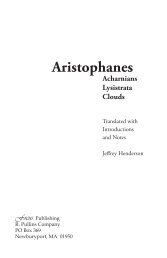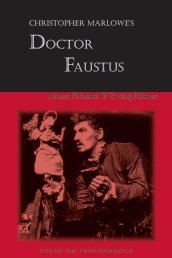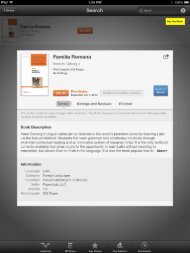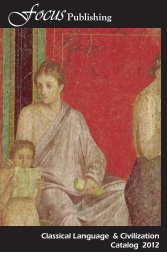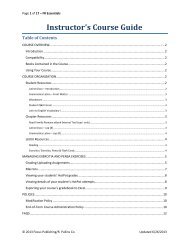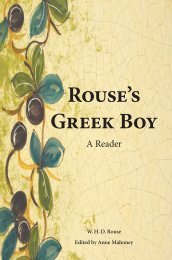ROMAN COMEDY - Focus Publishing
ROMAN COMEDY - Focus Publishing
ROMAN COMEDY - Focus Publishing
- No tags were found...
Create successful ePaper yourself
Turn your PDF publications into a flip-book with our unique Google optimized e-Paper software.
4 Ro m a n Co m e d ythe still predominant modern trend toward theatrical realism or naturalism. Menanderprovided the source plays for Terence’s Adelphoe and Eunuchus.Menander died well before the beginnings of Roman drama in 240 BCE. But hisplays and those of other New Comedy playwrights such as Diphilus (b. ca 360-350BCE), who provided the source play for Plautus’ Rudens, enjoyed frequent revivalsin Athens. They were also performed throughout the Hellenistic world by itinerantacting companies such as the famed “Artists of Dionysus.” Parts of southern Italy andSicily, though under Roman control, had been colonized by Greeks centuries earlier,and the earliest Roman playwrights, such as Livius Andronicus, were probablyexposed to Greek comedy there. Though the genre they created came to be known asthe fabula palliata, or “play in Greek costume,” Roman playwrights did not slavishly“translate” Greek New Comedy, but, rather, adapted it for the Roman stage and fortheir Roman audiences. The extant fragments of the earliest Roman playwrights, forinstance, reveal the addition of musically elaborate songs, or cantica, which do notcorrespond to anything in Greek New Comedy.Native forms of Italian comedy 2 were also instrumental in this process that is bestdescribed as creative adaptation, and seem to have had a major influence on Plautus.These forms of popular Italian drama were unscripted in Plautus’ and Terence’s day,and so we only know of them through later testimony or the fragments of much laterscripted versions. One popular form of comedy was Atellan farce, so named becauseof its origin in Atella in Campania. These performances were short, largely improvisedskits involving masked, stock characters such as Bucco (“Fool”), Maccus (“Clown”),Manducus (“Chomper-Man”), and Pappus (“Grandpappy”). There were certainfixed routines and situations, which were probably full of slapstick and vaudevillelikecomic banter, traces of which are not infrequently found in Plautus. Mime wasanother form of popular Roman entertainment, also unscripted in the early period,and nothing like mime today. Mime actors and actresses (a rare example of the use offemale performers in European theater before relatively recent modern times) had areputation for bawdiness. They were nicknamed “flat-foots” because they performedbarefoot. The actors’ costumes sported large phalli and the actresses sometimesappeared in the nude. Mime troupes likewise performed stock scenes calling forimprovisation, and they seemed to have favored short, bawdy skits, including thosefeaturing adultery. Another form of highly farcical comedy called phlyax drama,which survives primarily through 4 th century BCE depictions of scenes on vases,flourished in southern Italy. Mythical burlesques, especially plays featuring the figureof Herakles/Hercules, seem to have been very popular in phlyax drama. 3Roman TheaterRoman plays were primarily performed in connection with state-sponsoredreligious festivals, and, like the other entertainments that took place in this festivalcontext, were referred to as ludi (“games”). They were also sometimes performed in2 For these, see further Panayotakis (2005b).3 For the phlyax plays, see further Bieber (1961): 129-46.





